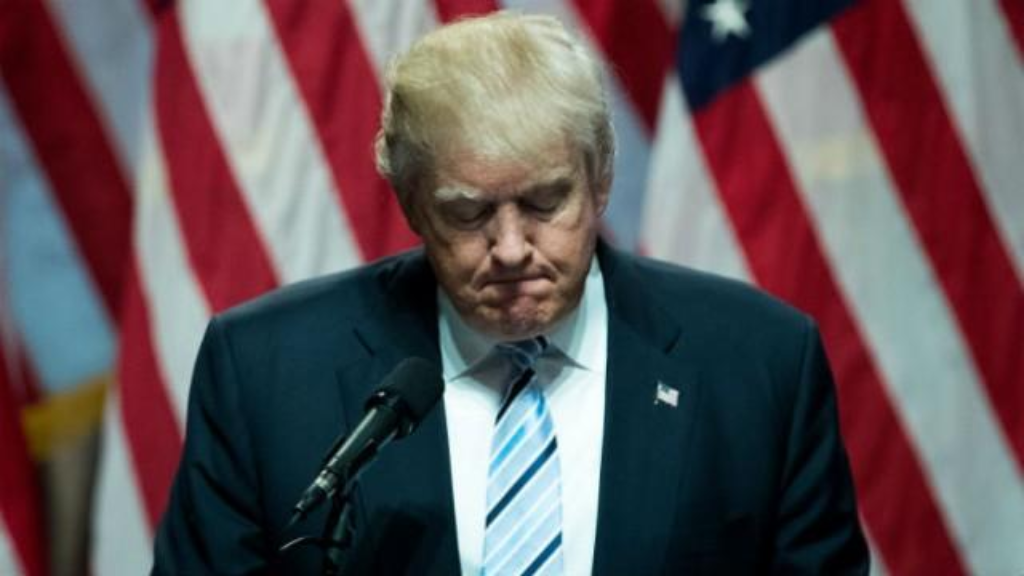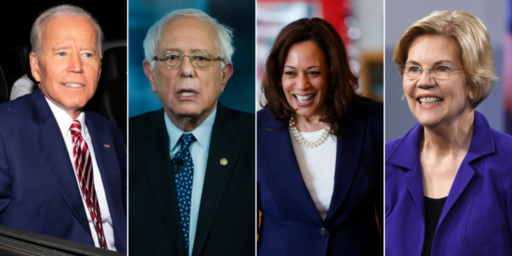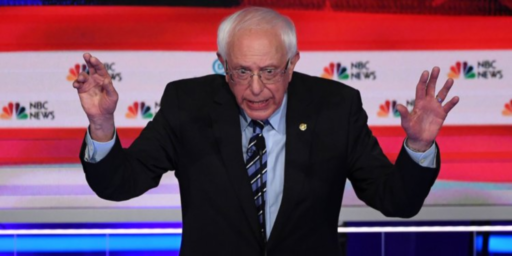Trump Trails Most Major Democratic Candidates In Head-To-Head Polls
It's still way too early to be predictive, but the latest head-to-head matches between the President and the top contenders for the Democratic nomination.

The 2020 General Election is seventeen months away, but new national head-to-head polling shows that President Trump is trailing all of the current top contenders for the Democratic nomination.
First up there’s a new Quinnipiac University poll:
Former Vice President Joe Biden leads President Trump by 13 points nationally, according to the latest Quinnipiac University survey.
In a national head-to-head matchup, the poll found Biden taking 53 percent against 40 percent for Trump, with the poll’s assistant director describing it as a “landslide” margin.
Five other Democratic contenders also lead the president: Sens. Bernie Sanders (I-Vt.), Kamala Harris (D-Calif.) and Elizabeth Warren (D-Mass.) hold healthy leads over Trump, with Sanders up by 9 points, Harris ahead by 8 and Warren leading by 7.
South Bend, Ind., Mayor Pete Buttigieg (D) and Sen. Cory Booker (D-N.J.) lead Trump by 5 points, with each posting a 47 to 42 split
“It’s a long 17 months to Election Day, but Joe Biden is ahead by landslide proportions,” said Tim Malloy, assistant director of the Quinnipiac University Poll.
Biden’s double-digit lead over Trump is largely driven by the gender gap.
The former vice president edges Trump 47 percent to 46 among men. But among women, Biden leads by 26 points, 60 to 34.
Similarly, white voters are split evenly between the two, with Trump at 47 percent and Biden at 46. But Biden leads 85 to 12 among black voters and 58 to 33 among Hispanics.
Both candidates surpass 90 percent support from within their own parties, but independents break for Biden by a 58 to 28 margin.
National polls are not necessarily the best indicator for a general election, which will be fought in a handful of swing states.
In 2020, Michigan, Pennsylvania and Wisconsin will be the primary battlegrounds.
Trump became the first GOP nominee since 1988 to win those three states. If the rest of the 2016 map stays the same but Democrats are able to win those back, they’ll win the Electoral College.
The numbers are similar in the latest poll from Politico and Morning Consult:
Sen. Bernie Sanders (I-Vt.) and former Vice President Joe Biden hold double-digit leads over President Trump nationally, according to a new poll that focused on hypothetical 2020 election match-ups.
The Morning Consult/Politico survey, which was released Wednesday, found that Biden carried an 11-point lead among registered voters in a hypothetical match-up against Trump. Sanders held a 10-point lead in a match-up against the president.
In the match-up between Biden and Trump, 44 percent of voters said they’d choose the former vice president, while 33 percent said they’d vote for Trump. Twenty-four percent of respondents said they were undecided.
Sanders carried 42 percent of the vote in his match-up against Trump. Thirty-two percent of respondents said they’d vote for Trump if he faced Sanders, with 26 percent saying they were undecided.
The survey also showed Sen. Elizabeth Warren (D-Mass.) in a statistical tie against Trump. Thirty-three percent of respondents said they’d vote for Trump, while 32 percent said they’d pick Warren. Thirty-five percent of respondents said they were undecided about the match-up.
Meanwhile, Trump held small leads over Sen. Kamala Harris (D-Calif.), Sen. Cory Booker (D-N.J.), former Rep. Beto O’Rourke (D-Texas) and South Bend, Ind., Mayor Pete Buttigieg (D).
Morning Consult noted that Trump did not receive more than a third of the vote in any of the hypothetical 2020 match-ups.
As The Washington Post’s Aaron Blake notes, this is not good news for the President:
The findings mirror the limited head-to-head polling we’ve seen in some key early states, with Trump trailing by as much as double digits in crucial Michigan and Pennsylvania, and even trailing Biden in Texas (!) in another Quinnipiac poll. Trump also trails in most national head-to-heads, although often not by as much as Quinnipiac indicates.
As with all polling at this early a juncture, it should not be used to predict any outcomes. Things can and will change. Biden, most notably, remains very popular from his time as vice president, and few analysts expect he’ll be able to maintain that for an entire campaign.
But these polls are beginning to paint a pretty unified picture of Trump’s current political standing as the 2020 race lurches to a start, and it’s decidedly not a strong one. And if there’s one thing the last two years have shown us, it’s that Trump’s political standing hasn’t changed much.
(…)
As ominous as the general election matchups in the new Quinnipiac poll are some of the other questions it posed. For instance, the vast majority of the country (7 in 10 people) regards the economy as good — a finding that would appear to be Trump’s ace in the hole. But 41 percent say it’s good and also credit Trump for that. Among independents, 6 in 10 either say the economy is not good or that Trump deserves no credit. Thirty-four percent think it’s good, thanks to Trump.
Trump also trails each Democrat among independents by at least 15 points, so even if you think the sample is off in some way, that’s a pretty grim starting point. Trump won independents in 2016, according to exit polls, by four points. He trails Biden among them by 30 points.
These polls came just days after The New York Times reported that internal polling for the Trump 2020 campaign showed him losing to potential Democratic challengers in seventeen states, including a number that he would need to hold on to if he were to maintain the Electoral College lead he won in the 2016 election. These internal polls, which have since been released, apparently bothered Trump so much that he instructed his aids and spokespersons to lie to the media if and when they are asked about poll numbers, something that Trump himself did when questioned about the Times report by ABC News anchor George Stephanopoulos. Instead, Trump claimed that all of his internal polling shows him leading his potential challengers, a claim that is largely belied by the fact that neither the White House nor the Trump campaign seems interested in releasing the details of these alleged new polls that Trump is referring to.
As Blake notes in the piece quoted about, and as Perry Bacon emphasizes in a post at FiveThirtyEight, head-to-head General Election polling this early in the race should be taken with a grain of salt to say the least.
For one thing, it is simply far too early to be of any real predictive value. There are any number of things that could happen between now and November 3, 2020 that will have an impact on the outcome of the election. This includes international developments and the state of the economy, which is fairly good now but could slow down significantly between now and Election Day.
Second, the Democrats have not chosen a nominee yet and even if it is one of the men or women that are included in these head-to-head polls we have no idea what their public perception will be by the time the General Election season starts.
Finally, the polling that is being done today is, at best, just guessing at what the voter turnout models are going to look like as we get closer to Election Day. Several recent reports seem to indicate that the experts are guessing that both Trump supporters and Trump opponents are going to be highly motivated to vote, Some are even predicting that turnout in 2020 will be higher it has been in previous elections. Until we have a better idea of who will be voting these polls are wild guesses at best.
That being said, Blake is correct to say that these numbers are not looking good for Trump right now. Given how he has reacted to bad news in the past, that’s likely to mean that he’s going to lash out at supporters and opponents alike to try to distract from a news cycle that is overwhelmingly negative for him.






No.
He doesn’t.
He leads all polls by the biggest numbers ever seen. People are saying they’ve never seen leads in polls so big. Its amazing. Really. And he has those numbers despite all the Presidential Harassment. Never in history have wee seen poll numbers so strong. People are saying they might be the biggest leads ever in the history of history of polls.
Trump is stuck at 42% . Every polling average, every head-to-head, every week, Trump is at 42%.
I know all the caveats about early polling, but I don’t recall ever seeing any politician super-glued to a number the way Trump is stuck on 42%. For two years and he’s been at 42% . How many times has he reached 50%? Never times. Strong economy, no new wars: 42%. Advantages of incumbency: 42% . The degree to which Trump has grown on us? 0%.
Without intending to we have discovered a fascinating fact: Bigots + Morons + Greedy Swine = 42%. It’s sort of like discovering the golden mean or fractals or something. A law of nature. Haters, Idjits and Piggies =42.
It’s time to admit that Douglas Adams may have stumbled onto a universal truth.
Are these polls using raw popular support, or is it weighted based on electoral votes? As we saw in 2016, Trump can trail the Democrat significantly in the popular vote and still win electorally.
If things look bad for Trump in Florida watch the Republican-controlled state change up their rules to allow proportional allocation of EC votes. It’s their trump card, so to speak.
Indeed. The election is almost a year and a half away. The Dems haven’t even named a candidate yet and Republicans have barely begun lying.
@michael reynolds: The crazification factor was rather famously calculated at 27% during the George W Bush presidency. That was Bush’s lowest approval rating, and the percentage Alan Keyes got in his senate campaign against Obama.
That 15% rise frightens me.
Also, the Presidency can be won with 46%. If Trump’s approval doesn’t dip, the Democrats have to run a pretty clean sweep of everyone else, keeping the “I would have voted for a Democrat, has they not nominated a socialist gay woman like Joe Biden who is going to force his transgender agenda down our throats. I just don’t want to have a beer with him, and he touches women with the wrong level of inappropriateness — more or less inappropriate would be fine” crowd to near zero.
The worry about polls like these is the influence they have on the Democratic primary. How many voters will think “I would really like to see Warren/Buttigieg/Harris as the nominee – Joe’s much too old – but it looks like he has the best chance of beating Trump so I suppose I should support him.” It would be good if Democrats ignored these kinds of polls and voted for the candidate they believe will make the best president.
@Stormy Dragon:
It depends how you define “significantly.” Hillary won the popular vote by 2.1 points, which under normal circumstances would be considered a very narrow lead, though it’s a wider lead than any other candidate who has ever lost the EC with the exception of Samuel Tilden in 1876 (where the EC results were fishy).
Mathematically speaking, I suppose that in theory it’s possible for a candidate to win the popular vote by 80-20% and still lose the EC, but in practical reality that ain’t never going to happen, and in point of fact, it’s very probable no one who wins the popular vote by more than 4 points will ever lose the EC. The popular vote and the EC are just not that divorced from each other.
Of course there were times when the polls showed Clinton ahead of Trump in the popular vote by a lot more than 2 points (though she rarely broke 50%, which should have been a red flag: it showed there was a significant segment of the populace who were reluctant to support either candidate). So a candidate’s lead right now isn’t necessarily predictive of what will happen on Election Day. Still, it’s wrong to imply that the popular vote is some kind of meaningless metric that doesn’t tell us how the EC will go: in fact the two are highly correlated, despite the occasional election where the outcomes aren’t the same.
To put it another way: Biden’s 13-point lead in polls right now doesn’t necessarily mean he’d win next November, but he’d almost certainly win if he still had a 13-point lead.